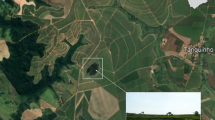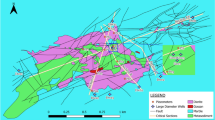Abstract
Hydraulic conductivity has paramount importance in hydrogeological and geotechnical studies. The estimation of hydraulic conductivity of aquifer materials is assessed through various methods, including laboratory measurements and empirical models. In this study, 60 different unlithified aquifer sediments obtained from the fluvial environment within the Himalayan Jhelum river basin were analyzed for their gradation characteristics, porosity, and hydraulic conductivities through standard procedures. The hydraulic conductivities of all the samples measured in the laboratory were compared with the values calculated through the most commonly used empirical equations to estimate hydraulic conductivity using sediment gradation characteristics developed in the past at different regions over the globe. It was observed that most of the empirical models significantly overestimated the hydraulic conductivity values except the empirical model developed by (Kozeny, Kozeny (ed), Hydraulik, Springer, Vienna, 1953). The statistical analysis revealed a poor correlation of R2 < 0.43 with high RMSE values of several orders of magnitude between the observed and estimated hydraulic conductivities. Modifications to the empirical models were done by optimizing their special beta coefficients and exponents, and applying d30 as an effective grain diameter for higher correlation statistics (R2) and fewer errors. The modified USBR model explained the highest around 61% variability of measured hydraulic conductivity values with error reduced to 1.00 m/day. The improved equation can be applied to the sandy aquifers of the investigated area for preliminary hydraulic conductivity estimation using grain-size analysis.







Similar content being viewed by others
References
Agrawal DP, Krishnamurthy RV, Kusumgar S, Nautiyal V, Authavale RN, Radhakrishnanmurthy C (1979) Chronostratigraphy of loessic and lacustrine sediments in the Kashmir Valley. India Acta Geol Acad Sci Hungaricae 22:185–196
Alyamani MS, Şen Z (1993) Determination of hydraulic conductivity from complete grain-size distribution curves. Groundwater 31(4):551–555. https://doi.org/10.1111/j.1745-6584.1993.tb00587.x
American Society of Testing and Materials (1995) ““Standard test method for particle-size analysis of soils”. ASTM standard D422–63. West Conshohocken, PA
American Society of Testing and Materials (2006) ““Standard test method for permeability of granular soils (constant head”)”. ASTM standard D2434–68. West Conshohocken, PA
American Society of Testing and Materials (2007a) ““Standard test methods for density of soil and rock in place by the sand replacement method in a test pit””. ASTM standard D4914–99. West Conshohocken, PA
American Society of Testing and Materials (2007b) ““Standard test method for density and unit weight of soil in place by the sand-cone method””. ASTM standard D1556–07. West Conshohocken, PA
Asoka A, Gleeson T, Wada Y, Mishra V (2017) Relative contribution of monsoon precipitation and pumping to changes in groundwater storage in India. Nat Geosci 10:109–117
Beyer W (1964) Zur Bestimmung der Wasserdurchlassigkeit von Kiesen ¨ und Sanden aus der Kornverteilungskurve. Wasserwirtschaft Wassertechnik 14(6):165–168
Bhat SU, Mushtaq S, Qayoom U, Sabha I (2020) Water quality scenario of Kashmir Himalayan Springs—a case study of Baramulla District, Kashmir Valley. Water Air Soil Pollut 231:454. https://doi.org/10.1007/s11270-020-04796-4
Boadu FK (2000) Hydraulic conductivity of soils from grain-size distribution: new models. J Geotech Geoenviron Eng 126(8):739–746. https://doi.org/10.1061/(ASCE)1090-0241(2000)126:8(739)
Brutsaert W, Nieber JL (1977) Regionalized drought flow hydrographs from a mature glaciated plateau. Water Resour Res 13(3):637–643. https://doi.org/10.1029/WR013i003p00637
Bureau of Indian Standards (1962) “Indian standard specification for test sieves”. IS: 460. New Delhi, India
Bureau of Indian Standards (1973) ““Indian standard methods of test for soils Part—2””. IS: 2720. Determination of water content. New Delhi, India
Bureau of Indian Standards (1974) ““Indian standard methods of test for soils—part 28””. IS: 2720. Determination of dry density of soils, in place, by sand replacement method, reaffirmed 2010. New Delhi, India
Bureau of Indian Standards (1985) ““Indian standard methods of test for soils Part— 4””. IS: 2720. Grain size analysis. New Delhi, India
Bureau of Indian Standards (1986) ““Indian standard methods of test for soils—part 17””. IS: 2720. Laboratory determination of permeability. New Delhi, India
Butler Jr (2019) The design, performance, and analysis of slug tests. CRC Press, Boca Raton
Carrier WD (2003) Goodbye, hazen; hello, kozeny-carman. J Geotech Geoenviron Eng 129(11):1054–1056. https://doi.org/10.1061/(ASCE)1090-0241(2003)129:11(1054)
Cashman PM, Preene M (2001) Groundwater lowering in construction: a practical guide. Spon Press, London
Chandel A, Shankar V (2021) Evaluation of empirical relationships to estimate the hydraulic conductivity of borehole soil samples. ISH J Hydraul Eng 1–10
Chapuis RP, Dallaire V, Marcotte D, Chouteau M, Acevedo N, Gagnon F (2005) Evaluating the hydraulic conductivity at three different scales within an unconfined aquifer at Lachenaie, Quebec. Can Geotech J 42(4):1212–1220. https://doi.org/10.1139/t05-045
Cirpka OA (2003) Environmental fluid mechanics I: flow in natural hydrosystems. J Hydrol 283:53–66
Dai Y, Shangguan W, Duan Q, Liu B, Fu S, Niu G (2013) Development of a China dataset of soil hydraulic parameters using pedotransfer functions for land surface modeling. J Hydrometeorol 14(3):869–887. https://doi.org/10.1175/JHM-D-12-0149.1
Daniel DE (1993) Geotechnical practice for waste disposal. Chapman and Hall, London
Dar RA, Mir SA, Romshoo SA (2019) Influence of geomorphic and anthropogenic activities on channel morphology of River Jhelum in Kashmir Valley, NW Himalayas. Quat Int 507(2019):333–341. https://doi.org/10.1016/j.quaint.2018.12.014
Fleckenstein JH, Niswonger RG, Fogg GE (2006) River-aquifer interactions, geologic heterogeneity, and low-flow management. Groundwater 44(6):837–852. https://doi.org/10.1111/j.1745-6584.2006.00190.x
Freeze RA, Cherry JA (1979) Groundwater. Prentice Hall, New Jersey
Ganju JL, Khar BM (1984) Tectonics and hydrocarbon prospects of Kashmir valley-possible exploration targets. Pet Asian J 207–216
Harleman DR, Mehlhorn PF, Rumer Jr RR (1963) Dispersion-permeability correlation in porous media. J Hydraul Div 89(2):67–85. https://doi.org/10.1061/JYCEAJ.0000863
Hazen A (1892) Some physical properties of sands and gravels, with special reference to their use in filtration. Massachusetts State Board of Health. 24th Annual Report. 39–556
Hazen A (1911) Discussion of dams on sand foundations. Trans Am Soc Civ Eng 73:199–203
Ishaku JM, Gadzama EW, Kaigama U (2011) Evaluation of empirical formulae for the determination of hydraulic conductivity based on grain-size analysis. J Geol Min Res 3(4):105–113
Jabro JD (1992) Estimation of saturated hydraulic conductivity of soils from particle size distribution and bulk density data. Trans ASAE 35(2):557–560. https://doi.org/10.13031/2013.28633
Jeelani G (2008) Hydrogeology of hard rock aquifer in Kashmir Valley: complexities and uncertainties. In: Ahmed S, Jayakumar R, Salih A (eds) Groundwater dynamics in hard rock aquifers. Springer, Dordrecht (Netherlands), pp 243–248
Jeelani GH, Shah RA, Hussain A (2014) Hydrogeochemical assessment of groundwater in Kashmir Valley, India. J Earth Syst Sci 123:1031–1043
Jose F (2016) Determination of hydraulic conductivities through grain-size analysis. M. Sc. Thesis submitted to Boston College (USA)
Kalbus E, Reinstorf F, Schirmer M (2006) Measuring methods for groundwater–surface water interactions: a review. Hydrol Earth Syst Sci 10(6):873–887. https://doi.org/10.5194/hess-10-873-2006
Kasenow M (2002) Determination of hydraulic conductivity from grain size analysis. Water Resources Publication, Colorado
Kozeny J (1953) Das Wasser im Boden. Grundwasserbewegung. In: Kozeny J (ed) Hydraulik. Springer, Vienna, pp 380–445
Maliva RG, Missimer TM (2010) Self-cleaning beach gallery design for seawater desalination plants. Desalination Water Treat 13(1–3):88–95. https://doi.org/10.5004/dwt.2010.1053
Masch FD, Denny KJ (1966) Grain size distribution and its effect on the permeability of unconsolidated sands. Water Resour Res 2(4):665–677. https://doi.org/10.1029/WR002i004p00665
Middlemiss CS (1910) A revision of the Silurian-Trias sequence in Kashmir. Geol Surv India 40:206–260
Middlemiss CS (1911) Sections in the Pir Panjal range and Sindh Valley, Kashmir. Rec Geol Surv India 41:15–144
Mir RA, Lone KA (2020) A recent scenario of groundwater quality in Kashmir, Northwest Himalaya, India. In: Bioremediation and Biotechnology, Vol 4. Springer, pp 39–63
Missimer TM, Watson I, Maliva RG, Pankratz TM (2009) Water supply development, aquifer storage, and concentrate disposal for membrane water treatment facilities. Schlumberger Limited, Texas
Mualem Y (1976) A new model for predicting the hydraulic conductivity of unsaturated porous media. Water Resour Res 12(3):513–522. https://doi.org/10.1029/WR012i003p00513
Mushtaq F, Pandey AC (2014) Assessment of land use/land cover dynamics vis-à-vis hydrometeorological variability in Wular Lake environs Kashmir Valley, India using multitemporal satellite data. Arab J Geosci 7(11):4707–4715. https://doi.org/10.1007/s12517-013-1092-1
Obianyo JI (2020) Investigation of empirical models for hydraulic conductivity from grain-size distribution. FUPRE J Sci Ind Res 4:60–70
Odong J (2007) Evaluation of empirical formulae for determination of hydraulic conductivity based on grain-size analysis. J Am Sci 3(3):54–60
Pinder GF, Celia MA (2006) Subsurface hydrology. John Wiley & Sons, Hoboken
Pliakas F, Petalas C (2011) Determination of hydraulic conductivity of unconsolidated river alluvium from permeameter tests, empirical formulas and statistical parameters effect analysis. Water Resour Manag 25(11):2877–2899. https://doi.org/10.1007/s11269-011-9844-8
Pravedny GH (1966) Design and selection of grain size composition of filter beds for the transition zones of large dams. Energiia, Moscow
Rosas J, Lopez O, Missimer TM, Coulibaly KM, Dehwah AH, Sesler K, Lujan LR, Mantilla D (2014) Determination of hydraulic conductivity from grain-size distribution for different depositional environments. Groundwater 52(3):399–413. https://doi.org/10.1111/gwat.12078
Sahu S, Saha D (2016) Empirical methods and estimation of hydraulic conductivity of fluvial aquifers. Environ Eng Geosci 22(4):319–340. https://doi.org/10.2113/gseegeosci.22.4.319
Salarashayeri AF, Siosemarde M (2012) Prediction of soil hydraulic conductivity from particle-size distribution. Int J Geol Environ Eng 6(1):16–20. https://doi.org/10.5281/zenodo.1055779
Sanchez-Vila X, Guadagnini A, Carrera J (2006) Representative hydraulic conductivities in saturated groundwater flow. Rev Geophys 44(3). https://doi.org/10.1029/2005RG000169
Schwartz FW, Zhang H (2003) Groundwater. John Wiley & Sons Inc, New York
Singh IB (1982) Sedimentation pattern in the Karewa Basin, Kashmir Valley, India, and its geological significance. J Palaeontol Soc India 27:71–110
Slichter CS (1899) Theoretical investigation of the motion of ground waters. The 19th Ann. Rep. US Geophys Survey 304–319
Song J, Chen X, Cheng C, Wang D, Lackey S, Xu Z (2009) Feasibility of grain-size analysis methods for determination of vertical hydraulic conductivity of streambeds. J Hydrol 375(3–4):428–437. https://doi.org/10.1016/j.jhydrol.2009.06.043
Tanner WF, Balsillie JH (1995) Environmental clastic granulometry. Geological Survey Special Publication, Florida
Terzaghi K (1925) Principles of soil mechanics. Eng News-Record 95(19–27):19–32
Uma KO, Egboka BCE, Onuoha KM (1989) New statistical grain-size method for evaluating the hydraulic conductivity of sandy aquifers. J Hydrol 108:343–366. https://doi.org/10.1016/0022-1694(89)90293-X
Vukovic M, Soro A (1992) Determination of hydraulic conductivity of porous media from grain-size composition. Water Resources Publications, Colorado
Wadia DN (1975) Geology of India. Tata McGraw-Hill, New Delhi
Wang JP, François B, Lambert P (2017) Equations for hydraulic conductivity estimation from particle size distribution: a dimensional analysis. Water Resour Res 53(9):8127–8134. https://doi.org/10.1002/2017WR020888
Zaz SN, Romshoo SA, Krishnamoorthy RT, Viswanadhapalli Y (2019) Analyses of temperature and precipitation in the Indian Jammu and Kashmir region for the 1980–2016 period: implications for remote influence and extreme events. Atmos Chem Phys 19(1):15–37. https://doi.org/10.5194/acp-19-15-2019
Zhang Y, Schaap MG (2019) Estimation of saturated hydraulic conductivity with pedotransfer functions: a review. J Hydrol 575:1011–1030. https://doi.org/10.1016/j.jhydrol.2019.05.058
Acknowledgements
The project is implemented by NPIU, which is a unit of MHRD, Govt. of India, for implementation of World Bank Assisted Projects in Technical Education. The productive discussions and invaluable assistance in conducting field operations, the contributions of Amir Khanday, Waseem Ahmad, Jasir Mushtaq, and Mir Dabeer are highly appreciated.
Funding
This work was financially supported by the Technical Education Quality Improvement Programme (TEQIP-III).
Author information
Authors and Affiliations
Corresponding author
Ethics declarations
Conflict of interest
The authors declare no competing interests.
Additional information
Responsible editor: Broder J. Merkel
Rights and permissions
About this article
Cite this article
Khaja, M.A., Shah, S.R. & Jha, R. Evaluation of empirical models for estimating hydraulic conductivity using gradation characteristics of unconsolidated fluvial sediments. Arab J Geosci 15, 720 (2022). https://doi.org/10.1007/s12517-022-10002-y
Received:
Accepted:
Published:
DOI: https://doi.org/10.1007/s12517-022-10002-y




